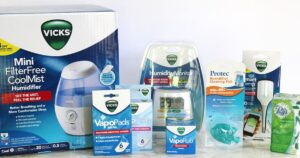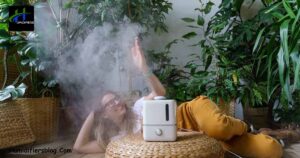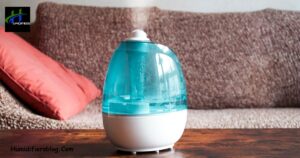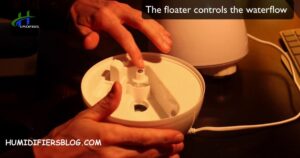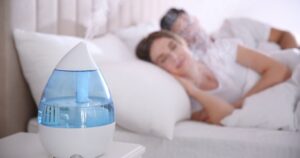Humidifier smell refers to an unpleasant odor that can develop when water in the humidifier’s reservoir becomes stagnant. This can lead to the growth of mold, bacteria, or other microorganisms, producing a musty or foul scent. Regular cleaning and maintenance of the humidifier can help prevent such odors.
Curious about the mystery behind Why Does My Humidifier Smell? Unpleasant odors often stem from stagnant water, fostering bacteria and mold growth. Using tap water with impurities exacerbates the issue. Dive into the solution , your humidifier into a fragrant oasis.
Stagnant water, bacterial growth, and the use of tap water laden with impurities are key culprits. In this exploration, we delve into the reasons behind the mysterious aromas emanating from humidifiers and uncover practical solutions to ensure a refreshing and comfortable indoor environment.
The Culprits Behind the Odor
The odor from humidifiers often stems from stagnant water, providing a breeding ground for bacteria and mold. Mineral deposits, common in hard water areas, contribute to a musty or metallic smell as they accumulate in the humidifier. Mold and mildew growth in poorly maintained humidifiers release spores, adding an unpleasant dimension to the indoor atmosphere.
Stagnant Water
Humidifiers, by their nature, involve water. When water stagnates within the humidifier for an extended period, it becomes a breeding ground for bacteria, mold, and other microorganisms. These unwelcome guests release unpleasant odors that can permeate the air.
Mineral Deposits
Many regions have hard water, which contains high mineral content. Over time, these minerals can accumulate in the humidifier, leading to a white, chalky substance. This not only affects the efficiency of the device but can also contribute to a musty or metallic odor.
Mold and Mildew Growth
Mold and mildew growth in humidifiers occurs when moisture and warmth create an ideal environment for these fungi. The release of mold spores into the air can lead to not only an unpleasant odor but also potential respiratory issues. Regular cleaning and maintenance, like remembering to put cleaning solution in the humidifier on a weekly basis, are crucial to preventing the development of mold and mildew in humidifiers.
Putting in disinfectant as recommended helps kill any fungi or bacteria trying to grow in the standing water orwet components. Doing so protects air quality and inhibits further mold spread when water droplets are emitted from the humidifier. Consistent care by properly putting in cleaner inhibits problems down the line.
Dirty Humidifier Filters

Humidifier filters, tasked with trapping impurities, can become a source of foul smells as they accumulate dirt and bacteria. Neglecting the regular cleaning or replacement of these filters compromises indoor air quality. Maintaining a clean filter is essential for efficient humidification and to prevent the release of contaminants into the air.
Health Implications
The presence of mold, bacteria, and contaminants in humidifiers can compromise indoor air quality, leading to respiratory issues for individuals with allergies or asthma. Inadequate maintenance may contribute to skin irritation, contradicting the intended benefits of humidification. Ensuring a clean and well-maintained humidifier is vital to mitigate potential health implications and promote a healthier indoor environment.
Respiratory Issues
The presence of mold, bacteria, and other contaminants in the humidifier can compromise indoor air quality. Breathing in air contaminated with these substances may lead to respiratory issues, especially for individuals with allergies or asthma.
Skin Irritation
Humidifiers are often used to combat dry skin, but if not maintained properly, they can have the opposite effect. The release of mold spores and bacteria into the air can contribute to skin irritation and exacerbate existing skin conditions.
Humidifier Lacks Ventilation Trapping Smells
If the humidifier is placed in a tightly enclosed space without fresh airflow, the moist air and smells have nowhere to circulate out, becoming trapped inside. Without proper ventilation, the stagnant humid air can’t disperse and lingers in the room. This allows any musty odors or fragrances emitted from the humidifier’s water tank or filter to concentrate, making the smells seem excessively strong or unpleasant over time.
Proper humidifier placement requires an open, ventilated area so moisture and airs have space to distribute. Enclosing the humidifier such as in a closet, cabinet, or the corner of a sealed bedroom blocks air circulation. The trapped humid air then has no way to diffuse, along with any smells coming from the machine itself.
Preventive Measures
Regularly cleaning your humidifier, using distilled water, and maintaining proper ventilation are vital preventive measures against unpleasant odors. Ensuring humidity levels within the recommended range with a hygrometer helps discourage mold growth and bacterial issues. These simple steps not only enhance the effectiveness of your humidifier but also contribute to a healthier indoor environment.
Regular Cleaning Routine

The most effective way to prevent unpleasant odors from your humidifier is to establish a regular cleaning routine. Follow the manufacturer’s guidelines for cleaning and disinfecting the device. This includes emptying and drying the water reservoir daily, cleaning the base and other components weekly, and replacing filters as recommended.
Use Distilled Water
Opting for distilled water in your humidifier reduces the risk of mineral deposits that can lead to unpleasant odors and compromise device efficiency. Distilled water lacks the minerals found in tap water, minimizing the potential breeding ground for bacteria and mold. Making this simple switch ensures cleaner and healthier humidification for your indoor space.
Proper Ventilation
Ensuring proper ventilation in the room where the humidifier is placed can help prevent the buildup of humidity and reduce the likelihood of mold growth. Opening windows or using fans can promote air circulation and discourage the development of musty odors.
Humidity Monitoring
Investing in a hygrometer to measure indoor humidity levels can be beneficial. Maintaining humidity levels within the recommended range (usually between 30% and 50%) helps prevent over-humidification and reduces the risk of mold and bacterial growth.
Infrequent Humidifier Maintenance Causes Funk
Not cleaning and disinfecting the humidifier regularly enables mold, bacteria, and mineral deposits to accumulate. Without frequent maintenance, microbes and minerals build up and thrive inside the stagnant humidifier water and tanks, releasing unpleasant and unhealthy funky odors.
It is important to follow the manufacturer’s directions on properly cleaning your humidifier. Infrequent humidifier maintenance fails to remove scale, residue, algae, and germs before they multiply. As these growthsfrom standing water, minerals, and microbes proliferate in the untended humidifier, they release increasing foul soggy smells into the air over time.
Troubleshooting

If your humidifier emits unpleasant odors, immediate troubleshooting is essential. Cleaning with a vinegar and water solution helps disinfect the device, but persisting smells may indicate the need to replace worn-out components like filters or wicks. Swift and targeted troubleshooting ensures the continued effectiveness of your humidifier and a fresher indoor environment.
Cleaning Solutions
If you’ve already noticed a smell from your humidifier, it’s essential to take immediate action. Cleaning solutions, such as a mixture of white vinegar and water, can be used to disinfect the humidifier. Ensure you follow the manufacturer’s guidelines and rinse the components thoroughly after cleaning.
Replacement Parts
If your humidifier continues to produce unpleasant odors despite cleaning, consider replacing components like filters or wicks that may have become ineffective. Over time, these parts can accumulate dirt and bacteria, contributing to lingering smells. Regularly replacing worn-out components ensures optimal performance and helps maintain a fresh and healthy indoor environment.
Frequently Asked Questions
How can I prevent my humidifier from producing odors?
Regularly clean your humidifier, use distilled water, ensure proper ventilation, and monitor indoor humidity levels to prevent odors.
Can the smell from my humidifier impact my health?
Yes, the smell from your humidifier can impact your health, potentially leading to respiratory issues and skin irritation due to the presence of mold, bacteria, or contaminants.
What should I do if my humidifier already smells?
If your humidifier already smells, clean it with a vinegar and water solution, and if the odor persists, consider replacing filters or other worn-out components for a fresher indoor environment.
Final Thoughts
Unpleasant odors from your humidifier typically indicate bacteria or mold growing inside the moist components. The water tank, filters, and crevices provide an environment where microbes multiply, especially if not cleaned regularly. As they proliferate, they produce smelly gases and waste that enters the air when the contaminated water evaporates.
Preventing odors requires diligent humidifier maintenance. Following manufacturer guidelines, thoroughly scrub tanks, dry out filters between uses, and disinfect all parts on a strict schedule. This removes contamination before stench-releasing bacterium and fungus establish colonies and spread through steam. With good cleaning habits, you can create inhospitable conditions inside the device to discourage microorganisms.

